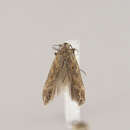tr
kırıntılardaki isimler


Scrobipalpa vasconiella is a moth in the family Gelechiidae. It was described by Rössler in 1877. It is found on the Canary Islands and Madeira, as well as in Algeria, Portugal, Spain, southern France, Sardinia, Sicily, Italy, former Yugoslavia, Greece, south-western Russia and Turkey.[1][2]
The length of the forewings is 5–7 mm (0.20–0.28 in). The dark fields of scales form a mosaic pattern on the forewings, which have a brown-reddish ground colour. The tip of the forewing is dark. The hindwings are light to dark dirty grey.[3]
Scrobipalpa vasconiella is a moth in the family Gelechiidae. It was described by Rössler in 1877. It is found on the Canary Islands and Madeira, as well as in Algeria, Portugal, Spain, southern France, Sardinia, Sicily, Italy, former Yugoslavia, Greece, south-western Russia and Turkey.
The length of the forewings is 5–7 mm (0.20–0.28 in). The dark fields of scales form a mosaic pattern on the forewings, which have a brown-reddish ground colour. The tip of the forewing is dark. The hindwings are light to dark dirty grey.
Scrobipalpa vasconiella is een vlinder uit de familie tastermotten (Gelechiidae).[1] De wetenschappelijke naam is voor het eerst geldig gepubliceerd in 1877 door Rossler.
De soort komt voor in Europa.
Bronnen, noten en/of referentiesScrobipalpa vasconiella is een vlinder uit de familie tastermotten (Gelechiidae). De wetenschappelijke naam is voor het eerst geldig gepubliceerd in 1877 door Rossler.
De soort komt voor in Europa.
Bronnen, noten en/of referenties Taxonomische informatie over Scrobipalpa vasconiella bij Fauna Europaea.Scrobipalpa vasconiella é uma espécie de insetos lepidópteros, mais especificamente de traças, pertencente à família Gelechiidae.[1]
A autoridade científica da espécie é Rössler, tendo sido descrita no ano de 1877.
Trata-se de uma espécie presente no território português.
Scrobipalpa vasconiella é uma espécie de insetos lepidópteros, mais especificamente de traças, pertencente à família Gelechiidae.
A autoridade científica da espécie é Rössler, tendo sido descrita no ano de 1877.
Trata-se de uma espécie presente no território português.